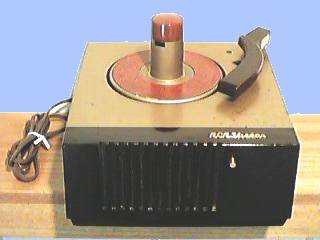 |
The Unofficial Duke&Banner Autobiography
"CRIMINALS"
CHAPTER
8: |
When we last left you, Bob and I were waltzing across a crosswalk with a 20-foot long 2X4. Happy to say that Truant Officer Wilkie paid no “official” attention to us while he idled in his Renault. As soon as we got out of his way, he continued his trek back to school.
A few of you have asked: “Bro Duke, how many records are in the RiverRatRadio library, and how did they get there?”
We can only estimate these days at 10,000+ 45RPM’s. I keep on building new racks. In the 50’s and 60’s, most were bought in supermarkets at 25 cents a pop, which were removed from jukeboxes.
The late 60’s would find me at various Thrifty Drug Stores buying distributor's overstock 45's at the Bargain Basement price of 10 cents a pop. Thrifty would advertise in our local newspaper, and I learned to show up one day before the sale started. I actually became a temporary employee by offering to un-box the records and make a display on their table. This was a win-win situation. It made me popular with Thrifty managers, and gave me first access to whatever was there. Most stores got about 2,000-3,000 records with many repeats, so it was sorta like finding a needle in a haystack. I had to flip through each one.
There were about 10 stores in my vicinity, so it kept me away from stealing hubcaps. Obviously I couldn’t hit all stores on the same night, and many store managers made a mess out of their display, throwing all the records in one big pile on a table. So on the stores that already had their "display" out, I carefully took each record and made easy-to-flip rows. Record sales continued on into the 70’s, which eventually led to a job offer from one manager, but I politely declined.
Thrifty introduced me to hundreds of copies of records by Ronnie Dove. In the summer of '64, he was having Top-10 hits on radio stations in the South. Droves of listeners deserted Rock&Roll stations to avoid the din of the Beatles. Ronnie had a couple of nationwide hits in the Top-20, none of which were played on LA radio stations, hence, the oodles of records in the bargain basement. He had over 20 charted hits, nationwide. What caught my eye was his arrangers: Ray Stevens and Bill Justis. First Class in my book. His records sound very much like Paul Anka with a country twang.
Today, Duke&Banner listeners should be proud: You are the only people west of the rockies who know that Ronnie Dove ever existed.
I should also mention Wenzel’s Record Town in beautiful low-overhead Downey. Mr. Wenzel is an interesting character. He dedicated his life to music. Just like Sun records in Memphis, the back of Wenzel’s store housed not only a recording studio, but a small record pressing plant as well. Many a group would cut records there, including The Rumblers. “Boss,” their surf instrumental released in ’63, made it to the Top 10 in Los Angeles. Wenzel sold the master to Dot, who released it nationally. It peaked at a dismal #87 on the Billboard charts.
The Chantay’s had a little better luck with “Pipeline.” Through Dot, it shot up to #4 nationally. Wenzel also pressed oldies. If a really obscure 45 was out of print, Wenzel had the answer. A brand new 45 with a white label. Nothing printed on that label except the title, and pressed on good plastic in Wenzel’s back room. Hopefully he paid royalties.
But the one thing that endeared me to Wenzel was his attitude toward me. I presented him with my problem: It was 1970. Paul Anka’s original ABC-Paramount hits were locked up in an RCA-Victor underground vault. RCA theorized that if they kept the original hits locked up, people would then flock to their local record store and buy the wonderful and tinny RCA album: “Anka’s Golden 21.”
Wenzel opened his current issue of Billboard and scanned the back pages of the classified ads. He began to emote: “Used records removed from jukeboxes...Paul Anka, Frankie Avalon, Patti Page…Most under a dollar…House Of Music, Ocean Park.” Yup, just like “Miracle On 34th Street,” Wenzel took the time to actually send me to a competitor!
Ocean Park was near Santa Monica. It was once called Pacific Ocean Park. Then it went bankrupt, leaving behind the ruins of many amusement park rides. Started in 1952, House Of Music was “manned” by a woman [womaned?] who was a Cherokee Indian and smoked cigars. Jane Hill (we called her “Lady”) ran the recycled records area of the store, her hubby Jimmy ran the jukebox business in the back. Not only did she have oodles of Paul Anka records, she had oodles of everything! About 100,000 45’s and albums were on display; nothing over a dollar. It was Nirvana.
The clientele was as diverse as the music. On one trip, she introduced me to Bob “The Bear” Hite, the harmonica player of Canned Heat. On another trip, a scantily clad man, who left no doubt about his sexual orientation, attempted to lure Bob over to his house for a “visit.” I knew exactly what the man wanted; Bob had no idea. I wandered over to Lady, who was rolling her eyes and snickering. Both of us tried to hold back the laughter.
Actual dialog transposed between Jane and Duke |
“Why is he going after
Bob?” I scratched my head. We both broke into laughter. |
Belive it or not, House Of Music is still alive. House Of "Records" (without the jukebox business) is being run by a family friend, Phillip Smith. Same oldies, same friendly service! You can access the website from above.
Second hand thrift stores were usually a good place haunt, although most of the records I ever found were so torn up, they weren’t worth my time. One day, however, I got a call from Don (who will talk about on future chapters.) “You gotta come down here now!” Don exclaimed. “Where?” I bit my lip. “Paul Anka…new, and never played, at the Am-Vets building!” Needless to say, I darted to my wheels and spared no horses in getting to the Am-Vets thrift store in nearby low-overhead Azusa. It was everything I would hope for and more. Multiple copies of “Puppy Love” and lots of other stuff, mostly misses from the same year: 1960. About a thousand 45’s. They must have been molding in some record distributors closet. I had just enough time to finish looking before the store closed.
The amazing conclusion to this story: Not more than a week or two later, Duarte High School held its annual carnival. One of the booths was proudly entitled “Throw The Baseball At The Record.” They bought every 45 at the Am-Vets store, hours after we picked through the pile. I forgot exactly what you won if you smashed a 45, but I felt relieved. Thanks to Don, the good ones had been removed, and were safe in the library. After the carnival, they threw the remains of the records in a dumpster, and I proved that I will go to any length to get a record: I dove in to retrieve them.
Yes, in-between the corndog wrappers, mustard, ketchup and used coffee grounds...I uncovered gold! Make that tarnished silver. Hey, if you ever need a copy of Don & Dewey’s “Heart Attack” (released on Highland) or Narvel Felts belting it out with his version of: “Honey Love,” (released on Pink) or Rick Lancelot singing [and we use that term loosely] "The Rebel Yell" (released on the Turban label) let me know. After 33 years, I’m still hanging on to them! "Honey Love" peaked at #90 in Billboard, "Rebel Yell" and "Heart Attack" didn't even score. They're so bad, even I tremble in my boots at the thought of broadcasting them!
And to protect the guilty, I won't tell you which popular lowrider band also recorded "Happy Hippo Polka." I only have 5 copies of that one. One copy still has ketchup stains. Or is that blood? Of the band?
I also recently uncovered about 25 copies of Al Hirt blowing his big RCA-Victor miss: "Feelin' Fruggy." I auditioned it recently. In a word: It really sucks!
I can hear you all asking: "But Bro Duke, why would you want to hang on to those duddy-wuddies for over 3 decades?"
I dunno. Anybody got a baseball the'd like to donate?
Another source for records came in the form of “cutouts.” Sutton Record Distributors in New Jersey found a nitch market with overstock 45’s. They would go around the country, collecting other distributor’s overstock, then wrap them in a brightly colored plastic sleeves. They marketed them mostly in lower economic department stores like K-Mart at the remarkable price of 39 cents.
The cutouts had to be clearly marked so they could not be returned to the original distributor’s warehouse. The procedure for most distributors was to grab a sealed box of 100, then take a long bit and drill right through the top of a box. Hopefully the worker’s aim was on target! The goal was to drill through the paper label. However, every now and then a stray drill would find its way to the groove area and totally destroy the record.
ABC had a romantic answer to its cutouts. Instead of holes, they actually employed people to individually stamp a gold star on each and every record. Aww!!!
In the new millennium, I’m still getting more. Good friends will pull through and donate some. A dedicated listener sends me stuff from time to time, giving me mucho joy. Occasionally I run into a box of 45's and buy the whole box. And I still dumpster dive. At a Sebastopol Flea Market I discovered numerous Mantovani albums in a trashcan. Further examination, after brushing away the sticky snow cone and ice cream wrappers, revealed about 8 album titles of about ten copies each.
In my book, Mantovani is not exactly anything to write home about, but Rat and I managed to strap a couple dozen to the bike and rode home. Now, you’d think Bob would be totally grateful and excited when we presented him with 2 dozen Depressing Jazz records. After all, he could lay horizontal and fall asleep to some new music for a change. So I banged on his door. It opened, revealing a totally dark atmosphere. He took one look, snorted a couple of times and emoted:
“Mantovani? He ain’t no Shearing.” With that he grabbed the albums and closed to door, retreating back to his horizontalness. What a guy!
| We discovered that Wenzel's Music Town is still alive and doing business at its original location. However, the end may be near according to this letter that was posted in a local Downey newspaper. |
| SAVE WENZEL’S MUSIC TOWN! I’m just an old-fashioned vinyl ’ho, and trekking down Wenzel’s with my want list every few months to stock up on oldies 45s has always been a special treat. Even its location, the forgotten land of Downey, feels like an atomic-age throwback, a Googie-rich suburb not yet marred by the epidemic of übergentrification and stucco tract mansions. Once inside the mom-and-pop store, one can browse at leisure through the inventory, which includes not only beloved vinyl, but every oldies-collection CD imaginable. Got a question? Don’t know the name of the song you’re seeking? Hum a few bars to Maxine or Tom Wenzel, the Ozzie & Harriet of rock & roll, and they’ll likely know it. But, alas, my oldies oasis is in peril. Open since 1958, the store had its lease renewed in June for very possibly its final year. In spite of recent downsizing — the "rarities" back room has been consolidated into the main area — business hasn’t been up to snuff. Not surprising, since my fave oldies radio stations, KRLA and KACE, went off the air in recent years. On the other hand, maybe a miracle will keep the store going. After all, Downey did save its landmark McDonald’s. Let’s prove we care as much about good music as bad food! LOCATION: 13117 Lakewood Blvd., Downey (Nipper Seaturtle) |
Nipper Seaturtle?! Oh, but I digress...Finally, I should make a few words about quality. Look, I'm an audio nut. When I buy a record or CD, I expect it to be EXACTLY as the original hit. Some engineers will argue that you can't expect perfection from a 40 year old recording. To some extent, that is true. But pressing records is a lost art, and CD companies are at the mercy of snake oil salesmen, or in some cases they are the snake oil salesmen.
For instance: Good D&B listeners know that there are 2 versions of Gladys Knight & The Pips "Every Beat Of My Heart." The VJ version is the national hit. Art Laboe knows this and uses it on his Original Sound releases. But there's a guy going around with the other version that really sucks. He's promised every record company that it's the original hit. Even Rhino got screwed. And you get screwed, everytime you buy it on an oldies compilation album and think it's the original!
Then there's the wonderful engineering concept of: "Hey, it's an old tape. Let's get rid of the noise." The equipment that does this trick [called audio squelch] became popular in the mid 80's. You won't notice it's there until you get to a low passage. An amazing thing happens: the low passage just...disappears. I have heard this on many a 45 reissue. Just drives me nuts!
Then there's the Strereo/Mono concept. Frequently, record companies used a different mix, or even a different take on the Stereo versions of their recordings. A good example: The Supremes belting out "My World Is Empty Without You, Babe." The original Mono 45 has a string section that won't quit. The Stereo version, which every oldies station in the country plays, has no string section at all. In it's place is a single saxophone from a sax player that really sucks!
And finally, here's some record trivia for ya. The 45RPM record was invented by RCA in 1948. RCA also introduced special 45RPM record players for the occasion, that were compatible with RCA vinyl 45's. They were small, and are quite a collector's item these days. Monarch Record Pressing Plant was the first non-RCA plant authorized to press 45's for smaller labels. While RCA or Columbia had dozens of in-house record presses, small labels had maybe one or two.
If a small label had a national hit, it became impossible to press enough 45's to fill every store nationwide. And as little as a week delay could be disasterous! Enter Monarch. On a moment's notice, Monarch was able to press and box 10,000 quality copies overnight. Monarch's signature was a triangle on the "dead wax" part of a record.
In the winter of '54, they had already pressed some 1300 different masters. By the winter of '66, that nuber was up to a whopping 64,000. And by then, each individual press run netted about One Hundred Thousand copies each. By the time CD's became popular, they had pressed an estimated total of One Hundred Billion copies! Hey, at a dollar each, that's slightly more than what the Prez wants to spend in Iraq!!
Everything worked fine until Monarch decided to try a cheaper plastic in 1954 called Styrene, at the request of Mercury Records. Soon thereafter, problems surfaced. The RCA players were tearing the grooves up. And the static-prone Styrene did a great job sucking up all the oil, especially from Seeburg jukebox mechanisms, making a new Syrene record sound like audio sandpaper in less than a damn week!
| The highly coveted RCA 45EY1, One of my first turntables. |
 |
RCA was fuming! Customers were revolting! Radio DJ's were steaming! Monarch engineers were huddling! They came out with a plan: Each press run would have 2 different plastic types. Type #1 was made mostly of tough, recycled plastic. It was noisey, but could withstand Seeburg's oil, RCA's heavy, non-compliant cartridges, and DJ's back-cuing. The Styrene ones were shipped to major cities where, hopefully, the populace had newer, more compatible equipment. Everyone was happy. Sorta.
Sensing lost record sales, Mercury ran a display ad in Billboard informing jukebox programmers that all was well. Tougher plastic was on its way. Seeburg ran an ad as well, suggesting that washing Strene records with soap and water would remove the static charge. And a few weeks later...Columbia, Dear Columbia, switched over to 100% PolyStyrene, except for select DJ copies.
Get to the point, will ya?
Oh, but I digress again....And so, what happened to the transmitter tests that summer? I spent a few weeks at Bob’s house testing out various antenna ideas, from vertical to long horizontal wires. Greeneye proved to be a useful tool, the eye showing very powerful signal strength as it overlapped. Transmitter power was a whopping 10 watts at 1620Khz, which was just above KWOW at 1600Khz, the highest frequency in the commercial band at the time. And while I was breaking a law, it didn’t hold a candle to the residents of Watts, some 30 miles away.
The first ever Watts riots in the summer of ’65 was an eye opening experience. I had no idea why they were burning down their town, but LAPD radio boomed in just above us at 1730Khz. Normally a call would go out at about one per minute. In this case, calls were backed up. For 3 days and nights, KMA-367, located in the mountainous Elysian Park area of Los Angeles, broadcasted non-stop calls of crimes in progress. It was riveting!
Does this mean my laundry is finally dry? |
"Negro criminals, they all are!" |
"The viewers love me!" |
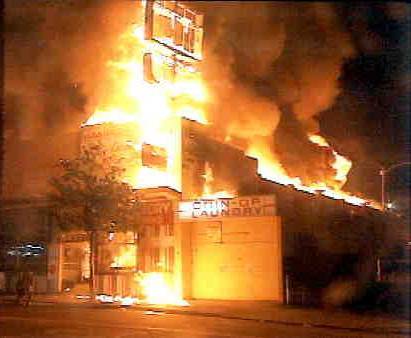 |
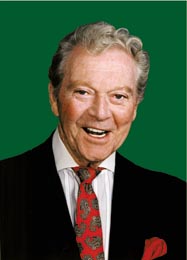 |
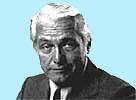 |
(L) The real George
Putnam today, minus his American Flag Lapel Pin. He does
Hate Talk radio now. |
KMA-367 was originally licensed as KGPL in 1931. It was the 1st Police Dispatch radio station in the nation. The transmitter had a power of 500 watts and was personally built by Lee Deforest, the man who invented radio. Click on KMA-367 to view a fascinating history of the station.
 |
The Original |
Of course, TV news had extensive reports of the riot. One of the pioneers of TV journalism was George Putnam. He was as right-wing as Hitler, and just plain weird. If you ever watched The Mary Tyler Moore Show, Newscaster Ted Baxter is modeled after Mr. Putnam.
I sorta watched the riot scenes in horror. Why would all these people want to burn down their whole town? Aside from the people being shot and killed, I thought about all the antique jukeboxes and pinball machines that were being torched, and maybe even a phonograph record or two that I was searching for.
It wasn't until 1979 that I would learn exactly why they rioted, when I witnessed LAPD in action with another minority group. Even though 24 years have passed, it still plays vividly in my mind. The man was almost beaten to death by LAPD. His crime? You'll love this! He wasn't on the sidewalk. I still visualize the blood pouring down his face. We'll get to that event in later chapters.
Even today, details are sketchy on human loss from the first riot, but Charles Fizer, the baritone of The Olympics (Western Movies) was one of the first causalities, shot dead by LAPD. The group had just signed a contract with a tiny Warner Bros. subsidiary label named Loma. “Good Lovin’” would go on to be a total flop, but the song caught the attention of another Warner subsidiary, Atlantic, who made a #1 hit out of it a few months later, using a new white group that developed a huge following: The Young Rascals.
Gee, white cover versions from a black-owned record company in 1965! What's wrong with this picture?!.
Was Fizer rioting, or was he just a victim of LAPD? We will never know. And Putnam offered no answer for the riots; he just stood behind LAPD all the way, sticking out his fat chest to accentuate the tiny American flag pin on his lapel. One point I did note, however: Why was Mayor Yorty hanging out in Japan on a junket as residents burned down his town? Hmmpf…Yorty and Putnam weren’t scoring many points with me.
And a final note: Riots involving Blacks was not a new problem in the U.S.A. A few years earlier, Blacks ripped apart Mississippi & Atlanta, which prompted an infamous Dragnet episode in which Jack (just give me the facts) Webb proudly proclaims to his partner: “There are many riots going on in this country from “Negroes” who are upset with their police department. But that will never happen here, Bill. We just started a recruitment program for “Negro” cops. LAPD may not be the biggest, but it’s the best.” Dum De Dum Dum. Guess What?! Less than a month after that episode aired, the riots started.
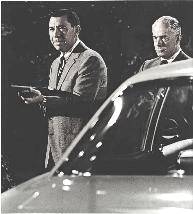 |
"DRAGNET" But Dragnet's crowning achievement in '65 was to bestow all the virtues of LAPD's sensitivity to minorities, just prior to the 1st LA riots. They erupted from LAPD's insensitivity of minorities, which came in the form of a repeated clubbing of a black teenager. |
"Hey, we're on the air...."
The antenna design that worked the best was adding even more poles to the 2X4. The Radio Shack Aluminum poles were designed to couple together and make one long pole, but 8 poles seemed to be the limit. Ten watts at Bob’s house, combined with the new, enormous antenna height of a whopping 44 feet, managed to broadcast The Olympics over a two-mile radius. It covered all of Duarte and parts of neighboring Monrovia! Plus, with Bob’s close proximity to Duarte High School, it delivered a powerful signal to our target crowd.
And so...we needed call letters. It didn't take long to figure out something:
Actual dialog transposed between Duke & Bob |
“I christen ye, KDHS.”
I said in my best Pirate Brogue. We played around with ideas most of the summer. |
My senior year at DHS was totally different. A Brook Benton song joyfully played as a theme song in my head: “I Got What I Wanted.” In Electronics class, Mr. Bassemier wanted to test my abilities and issued a challenge. He divided up the class into 2 teams. Jim Pearce was the leader of Team A; I was the in charge of Team B.
The goal: The first team that could successfully fabricate an AM crystal radio from scratch, wins. This involved winding a coil of wire with the correct amount of windings, and calculating the correct value of the tuning capacitor. We had to show the math involved, and then make it work. It had to be strong enough to power a supplied WWII headphone. [No, it wasn't a German WWII headphone!!] First team to finish the project is the winner.
Currently there was only one headphone, but Bassemier promised to bring in a second one when the game started. So I threw a curve: “Instead of headphones, can we build an audio amplifier?” Bassemier took two steps backward and scratched his head. “You still have to come in first to win.” “No problem.” I grinned.
Bassemier looked befuddled. We had 2 days to prepare. I was fortunate enough to have a German kid named Dennis Schultz on my team, who informed me that he excelled in upper-level math. Cool! I went to Thrifty that night and bought a brand new aluminum baking pan. I drilled holes for the tubes, clipped a few parts from an old TV, and threw everything in a cardboard box. My GE tube manual had a bare bones, easy to construct amplifier schematic. I modified it even further, taking out a couple of parts out of the schematic that weren't needed.
Bassemier opened a back room for me to solder it all together while Schultz did the math. While I was waiting for the soldering iron to warm up, I glanced around the room. There it was in all its blazing glory: A treasure. My treasure! Way in the back of the room were a dozen or so cardboard boxes. Their contents? All of the parts that I previously salivated over in Mechanical Drafting class!! Gee, was anybody looking? I grabbed a handful of small parts and stuffed it down a pocket in my jeans.
Yup, I was learning the art of robbing…or as Kookie would say: the art of Five Finger Discounts! And yup, it's true: I was well on my way of becoming a Master Criminal...a Public Enemy #1.
Near the end of the day, I had finished the amp. Our coil was being wound by another team mate, Dan Cicarelli. Schultz was to use his math skills to tell Cicarelli the amount of turns that the coil needed. However, due to my transmitter experience, I already had a rough idea how many turns that would take for the AM Broadcast band. I instructed Cicarelli to begin winding ahead of time.
I asked another team mate for a progress report: Five minutes to the bell, math not completed, but the coil was completed with the approximate amount of turns. "Excellent!" I chimed as I headed toward our work area with my new amplifier in tow.
Pearce’s team, just like our team, was still trying to compute the math. There was no coil, but they had most of the miscellaneous wiring done. And I must admit: Their wiring looked very professional compared to ours! I clipped on a variable capacitor salvaged from one of my Dad’s radio-destroying rampages, and brought it over to a long horizontal wire that Bassemier had strung for the antenna. Cicarelli brought the new amplifier in the shiny aluminum baking pan. Other team members circled around and I plugged in the amp, waiting for the tubes to warm up. [Unlike transistors, it can take up to a minute before you hear anything] Schultz continued to play around with his slide rule. [a precursor to the modern digital electronic calculator, but only a minor improvement over the Abacus]
I tapped the tube and heard some noise, indicating that the amp was ready. I tuned the capacitor. About mid-position, a very loud noise echoed trough the building. The entire team started jumping to the melodious sounds of Dick Sinclair’s Polka Parade on KFI, the strongest station on the west coast. It was loud! It was too loud! Reaching for the volume control...Oops! I forgot to finish the volume control wiring. It was stuck all the way up, which rendered a really huge distortion curve, and no way to turn it down.
This, of course, brought the attention of not only The Teach, but also Pearce, and probably many kids in nearby classrooms. Bassemier projected a grin. But it wasn't a "Gee, you won" grin...It was a "Gee, you went over my head" type of grin.
Your Basic Crystal Radio Set |
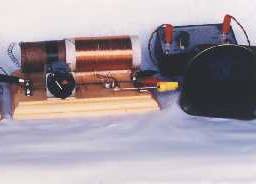 |
Pierce emoted: "I wasn't aware that a
Variable Capacitor was allowed in this contest?!" Followed
rapidly by The Teach's emote: "Where's the |
Jeez, Bassemier was beginning to sound like a bureaucrat! He cast a bewildered look over at Scultz, who was still fondling his slide rule and writing down figures.
Just then the school bell rang (fortunately for us) and Schultz had a whole night to play around with his slide rule and figure out the formula. The Teach insisted that we use a fixed capacitor, and it must match the math involved.
We finished the project the next day, about 10 minutes ahead of Pearce’s team. The prize? Bassemier brought in Hot Dogs. Yep, German Hot Dogs…more appropriately called Wiener Schnitzels. Sour Kraut as well. And just to show good team spirit, I shared half of my Kraut Dog with Pearce.
Meanwhile, back home: The tests at Bob’s house revealed one important fact: The taller the antenna, the further the signal traveled. I discovered that at 1620Khz, ground conductivity was also a factor, but not as important as height. Armed with the facts, I rebuilt the antenna at my house in Duarte. As Halloween edged closer, visions of a special broadcast danced inside my head.
Then the Sugar Plums congealed: What about a station that had a special holiday celebration for every major holiday? Not only would it keep me from stealing hubcaps, but since the holidays were well spaced, the FCC would have a harder time finding me. My record library had a dozen or so Spooky records…why not a party on the air!
And so I fired up the rig, put on a record, and called Bob. Since his radio was always on, I could get an instant reading:
“Bob, check
1620.” I held my breath in anxious
anticipation. He came back in less than a minute with the answer.
“The Purple People Eater?!”
Where did you unearth that ancient thing?” Bob razzed.
“We did it! We did it!!”
I jumped for joy, almost knocking a picture off the wall.
“It moves the eye. Not very
much, but the signal is crystal clear!”
“Two square miles, and it’s
all ours! KDHS, here we come!” I
giggled with delight.
This was the best news. I wandered around campus in a cloud, telling friends the good news, and asking them to spred the news. The first Official KDHS-1620 broadcast took place on Halloween night, 1965. Total power output from my homemade rig: A whopping 10 watts with one 6V6 tube supplying the power.
ORIGINAL TOP 10 AND FIRST OFFICIAL KDHS BROADCAST: 10/31/65 |
| 1. Monster Mash 2. Purple People Eater 3. Dear Jeepers 4. Addams Family Theme 5. (Laurie) Strange Things Happen 6. That Ol' Black Magic 7. Martian Hop 8. Igor's Party 9. Witch Doctor 10. Voodoo Man (Appetizer) That Ol' Black Magic (Sign-on Song): Igor's Party Instrumental |
Bobby Boris Pickett Sheb Wooley Jeepers Creepers Vic Mizzy Dickie Lee Bobby Rydell Ran-Dells Tony&Monstrositys David Seville Kay Starr Louie Prima/Keeley Smith Tony&Monstrosity Orch |
Garpax |
One
of the most unusual labels ever released. Found in a
Thrifty Drug Store for 10 cents in 1961. The Monarch code
dates the release as one year PRIOR to "Monster Mash."
No airplay in Los Angeles, except KDHS! |
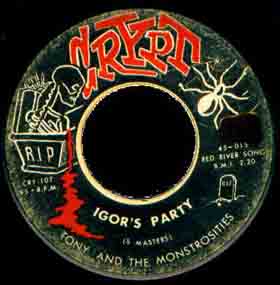 |
A few days after the Halloween broadcast, and I decided to call Bob…but there was no answer. Was he asleep? Were his parents passed out on the couch? Nope, none of the above.
Little did I know, but Bob and his parents were on an odyssey. The Hudson, soon to be the stationary Hudson Hotel, was transporting Bob, his Ma, and his Pa to the hospital. It was an emergency trip; Bob was doubled over in pain. Turns out Bob had a Ruptured Appendix, which often is fatal if not taken care of promptly.
Now, what conjures up in your mind when I mention the name: Methodist? Does it envision a humble Christian group that cares about their fellow human? Does it conjure up rich vistas of utopianism? Think again! Upon dragging Bob into the prestigious Methodist Memorial Hospital Emergency Room in beautiful downtown Arcadia, they were immediately directed to the admissions clerk.
Of course, she was busy with other customers. Bob laid down horizontally on 3 cold and wretched folding steel chairs. No Greeneye to stare back at him. Poor Bob!
Thirty minutes passed. As some of the pain momentarily subsided, Bob opened up an eye and glanced at the ceiling. Everything was white. Angelic music wafted to his ears. Hark! Was he in Heaven? Did he die? Was he Kaput?
The angelic chorus from the hospital’s Muzak system was suddenly interrupted by a deep voice. It was the admissions clerk. She was standing next to Bob in her white lab coat, with a pointy bra protruding. The wart on her nose was covered up by a more than ample supply of make-up. A decorative Harley chain wound tightly around her neck. The biker version of Tammy Fay Baker, she was. Her 284-pound torso and numerous skull tattoos on her arm said she meant business. A cigarette smoldered from her intense maroon-colored lips. Bob cringed. If this wasn't Hell, it was a damn good imitation!
Bob’s parents pleaded for help:
Actual dialog at Arcadia Meth. Hospital, as recorded by High-Tech Security Cameras: |
“Our
son is in a lot of pain.” Ma
exclaimed. The clerk pressed a finger into Bob’s abdominal area and got an immediate reaction: Bob screamed in pain. “Yep, looks like he needs his Appendix yanked out. Insurance?” A cloud of smoke from her mouth camouflaged the cigarette ash as it fell to the floor. “Insurance?
But we don’t have any.” Ma begged. The clerk’s animated arms accentuated her emotes, pulsating a Tortured Jesus Cross dangling from her Harley chain necklace. “But
that’s over 30 miles away.” Pa retorted,
worried if he’d get back home in time for the
opening of a new gallon jug of Red Mountain Vin Rose. “No…the Five Hundred goes to Methodist Memorial for services rendered. Actual ambulance cost is extra…and can vary…depending on the amount of stiffs that also need transporting at any given moment.” "Can we just pay you for the operation?" Ma pleaded. "Oh, sure...an Appendectomy will run ya...about Fourty." "Fourty Dollars?" Ma asked. "Fourty Thousand, Mac. And before we operate, you have to prove to us that you can pay up." “Which way to the hospital?” Pa’s eyes rolled. “Follow your nose down Huntington Drive, Route 66…you can’t miss it, Mac. Oh, and if I were you, I wouldn’t spare the gas. If that appendix bursts, your kid’s dead meat. ” “Thank you.” Ma tried to be civil. “Oh, thank you for considering Methodist Memorial!” She chimed as more ashes hit the floor. |
And so, Bob’s parents carried him out of the ER and back to the Hud. Bob sprawled out on the luxurious back seat, laying horizontal and feeling increased pain at every bump. The ailing Hudson was also feeling pain as it deposited an oil trail on the highway from its leaky and worn out motor bearings. Nobody was happy.
The Fine LA General Hospital, with absolutely no connection whatsoever to any organized religion, took Bob in with open arms and performed an immediate operation to save his life. Jeez, what’s wrong with this picture?
BACK HOME |
HAPPY HALOWEEN, KIDDIES! |